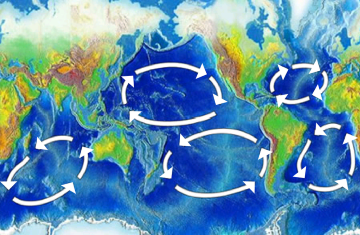680823_Ocean Gyres_360 px width.png

There are five major ocean gyres. These circular currents move clockwise in the northern hemisphere and counter-clockwise in the southern hemisphere. Credit: NOAA.
Much of the water in the world’s oceans is herded like cattle being driven to market—not by cowboys on horseback, but by strong currents. Known as gyres, they help control global temperatures and the nutrients available in different parts of the oceans. They also round up floating debris, forming giant garbage patches.
Gyres are formed by the winds, Earth’s rotation, and the land. Winds drag the ocean water, forming currents. The currents are deflected by Earth’s rotation. They’re pushed clockwise in the northern hemisphere, and counterclockwise in the southern hemisphere.
The surface currents drag the water below them, so the effects of the wind run deep. That sets up a “ring” of currents that circulate around the oceans. Finally, the land acts as a barrier, holding the currents in place.
There are five major gyres—two in the Pacific Ocean, two in the Atlantic, and one in the Indian. The water inside the gyres tends to be fairly calm. That prevents deep water from rising to the surface. Since the deeper water contains more nutrients, surface waters inside the gyres have less life than in the currents.
The gyres carry debris that was washed into the oceans from land. The debris forms large plastic “garbage dumps.” Bigger bits of plastic wear down into smaller bits that are gobbled up by fish, birds, and some of the ocean’s tiniest creatures. That’s a health hazard for the creatures, and for the people who eat them—rounded up by the “cowboys” of the open ocean.

